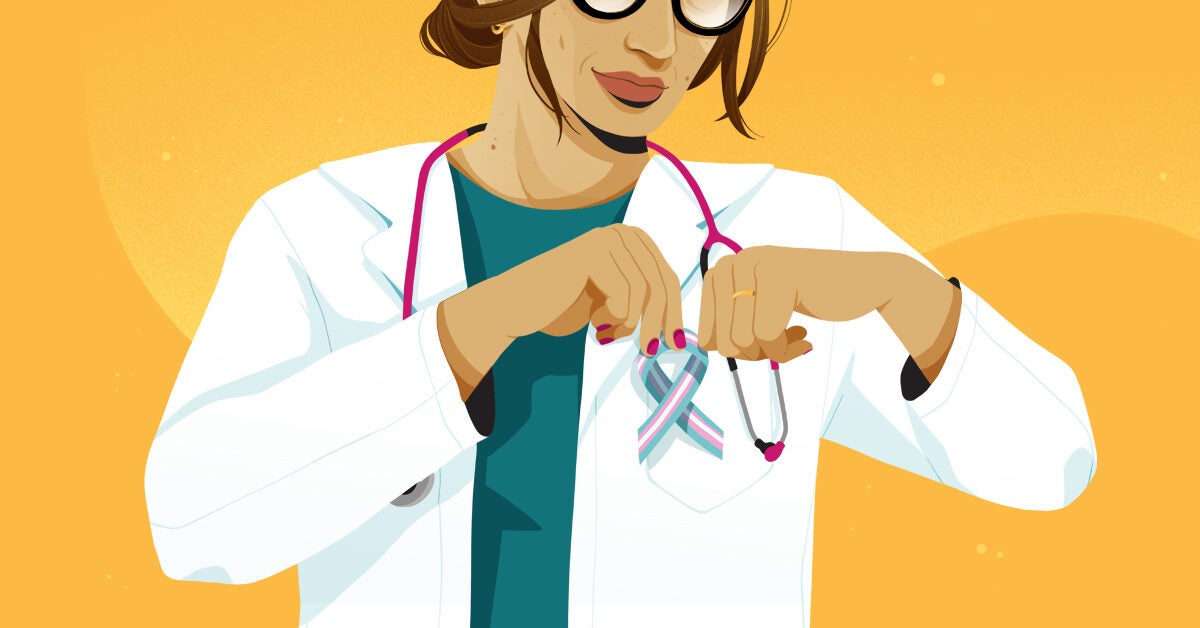
About two years ago, I had my first medical interaction as an out trans person.
Because LGBTQIA+ circles are the ones I call home, I decided to ask some friends about what I may be able to expect when seeking medical care. To my surprise, this inquiry sent me down a long and eye-opening journey into the state of healthcare for trans people in America.
Here’s what I learned about how doctors are failing trans patients, and tips on how we can do better.
For many folks, the first step to getting a general physical would be to find a healthcare professional. However, it isn’t that simple for many trans people — myself included.
A staggering 1 in 5 transgender people report being discriminated against in medical settings because of their identity.
It’s sad at best and scary at worst that trans people still have to use back avenues and whisper networks to know which medical professionals are safe to see. But alas, when it was time for me to get a physical, this is exactly what I had to do: I asked my friends for recommendations.
Transgender people are at a greater risk for unemployment due to workplace discrimination. Because of this, we are often uninsured or not insured with the same protections as our cis counterparts. Luckily, I get insurance through the marketplace, but for many trans folks I know, this isn’t the case.
When scheduling my physical, I got a short list of medical professionals who took my insurance. However, I soon discovered other significant challenges both during and after appointments.
Around half of trans people report having to teach their healthcare professionals about transness, and my experience was no different.
Even though the doctor I eventually saw was at least aware that trans people exist, the front staff misgendered me and called out my deadname in front of the entire audience of the waiting room. All this when I had clearly provided my correct name and pronouns on the paperwork before my appointment.
Although I can handle these mistakes at the moment, not everyone can. In some cases, this can lead to trans people discontinuing medical care entirely.
Many trans people also report experiencing harassment, and even physical violence, during appointments, in addition to medical and insurance incompetency.
There’s a lot that medical professionals can and should do to make their environments more trans-positive. Let’s go over some tactics that make all the difference for trans people seeking care.
Most people’s initial interaction with a medical practice will be through its website or over the phone.
When I walked through my now-primary care professional’s website, they had de-gendered language (“vaginal health” instead of “women’s health,” for example), inclusive intake forms, and an LGBTQIA+ section. All of these things suggested that I would be in good hands.
To create a welcoming and inclusive environment for all patients, especially trans people, intake forms should have a field for:
Sex assigned at birth and sexual orientation usually aren’t necessary to include on a medical intake form. However, some people may want their medical professionals to have this information, or it may be in some way specifically relevant to the cause of your visit.
Regardless of what someone’s insurance information says, a person knows — more than any clinician — how they want to be addressed. The form field additions listed above show prospective patients that their clinician is putting them in control of their own medical experience.
Also, these measures not only help trans people but any other folks who go by a name that’s not their legal name. It’s a win-win!
Due to their redundancy, the phrases “gender pronouns” and “preferred pronouns” are considered outdated and no longer in use. You can just ask for “pronouns.”
Another must for creating a trans-affirming medical space is ensuring that personnel who answer the phone are adequately trained in phone etiquette. It’s important to ask for a caller’s name and pronouns and to be ready to explain to people what pronouns are if a caller doesn’t know.
Medical settings are inherently educational, so people go to the doctor wanting to know more about their bodies and health. Why shouldn’t this setting also be able to educate on pronouns if need be?
Staff answering the phones at a medical practice should also prioritize asking for someone’s chosen name over their legal name. Also, they shouldn’t make assumptions based on a person’s voice.
Numerous times, I’ve been asked if I’m “making an appointment for my wife.” I’ve even been asked multiple security questions because someone doesn’t believe I am who I am. We need this to stop!
Most important, every person in your workplace — from administrators to clinicians — needs to have mandatorytraining on LGBTQIA+ health competency.
This could involve attending a panel or professional conference session, using free online resources, or hiring an expert to train your staff.
Your local LGBT center can likely help you access educational materials and refer you to a consultant for training. The center may even offer training services in-house.
Check out the end of this article for free online resources from national organizations and nonprofits.
All in all, these simple gestures — adjusting forms and online materials, training your staff in basic phone etiquette and LGBTQIA+ competency — create an affirming environment for all patients.
People should never have to worry about experiencing prejudice and unequal treatment when they go to the doctor (or anywhere). Having a visible and approachable antidiscrimination policy is essential, ideally next to the entrance or front desk.
It’s important to not only demonstrate respect and inclusivity to patients over the phone and during intake but during their entire experience at your practice.
Here is a list of things that medical professionals should NOT ask or say to trans patients during an appointment:
- What’s your “real” name?
- Have you had “the surgery”?
- Be patient with me. I’ll probably mess up your name and pronouns.
- There’s a lot I don’t understand about transgender people and issues. Can you teach me?
Healthcare professionals should never expect trans patients to be burdened with educating them about trans bodies, health, or identity. They should avoid asking unnecessary questions that have nothing to do with the patient’s visit — often posed entirely out of personal curiosity, not professional duty.
Countless times, one or more of these things have happened to trans folks I love, and they aren’t the only ones. It’s important that trans people feel less like an “experiment” or a sideshow attraction and more like a human being who needs a routine checkup. Keeping your unhelpful curiosities to a minimum preserves the dignity of the person sitting in front of you.
Much of the discussion around trans health focuses on gender affirming care (GAC). But trans people are people — we need to go to the doctor for a sudden illness, a chronic condition, or an annual physical like everyone else!
Trans literacy in the medical community is essential. When doctors take a Hippocratic oath to do no harm, that includes intentional or unintentional harm to trans people.
What a healthcare professional may think is just a small mistake in their attitude or treatment of a patient could negatively impact a trans person’s quality of life and well-being.
Trans people have
Everyone deserves access to safe, competent healthcare. There are so many other life obstacles that trans people navigate on top of medical care, including increased risk of unemployment and homelessness and a higher chance of being targeted with physical violence.
The least a healthcare professional can and should do is make the experience of seeking medical care as painless as possible.
This article provides tips for respecting trans patients before and during their appointments, which may or may not be about GAC.
Regarding GAC, the prevailing diagnostic criteria for gender dysphoria or incongruence come from the “Diagnostic and Statistical Manual of Mental Disorders (DSM-5)” and the International Classification of Diseases (ICD-11).
However, some doctors and patients alike find the inclusion of these diagnoses stigmatizing, creating a system of gatekeeping around GAC that harms trans folks and others.
It might be useful to know there’s a free, alternative resource for understanding GAC and trans health needs from the World Professional Association for Transgender Health (PATH). It’s called Standards of Care for the Health of Transsexual, Transgender, and Gender Nonconforming People.
Books and guides geared toward medical professionals working with trans patients also include:
Below are other trusted resources geared toward trans, nonbinary, and gender nonconforming people that may be useful to those seeking care and those providing it:
KB Brookins is a poet, essayist, and cultural worker from Texas. They are the author of How To Identify Yourself with a Wound (Kallisto Gaia Press, 2022); Freedom House (Deep Vellum Publishing, 2023); and Pretty (Alfred A. Knopf, 2024).
Follow them online at @earthtokb.








